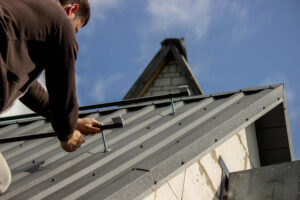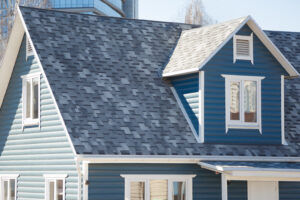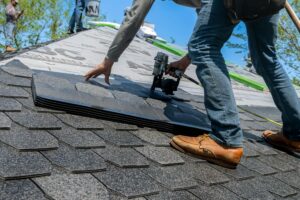Shingle roofs are popular because they are affordable and useful in most situations. If you are building a new home, replacing an old roof, or simply trying to learn about roofing, it is a great idea to learn all about shingle roofs, what they are, and how they perform so that you can make an informed decision. In this blog from 214 Roofing, we will examine the different types of shingle roofs, their pros and cons, installation tips, maintenance tips, and other information that can help you decide if a shingle roof is right for your home.
What Are Roofing Shingles?
Roofing shingles are individual overlapping elements laid in rows on a roof to protect the structure underneath from weather elements like rain, snow, and sunlight. They’re designed to shed water efficiently and add a polished aesthetic to the exterior of a home. Shingles come in various materials, thicknesses, shapes, and colors, offering flexibility in design and functionality. Keep on reading to learn more about roofing installation for your home and businesses.
Let’s discuss some of the common shingle roofing materials:
Common Types of Shingles
Are you thinking about installing a new roof on your home or another building? First, it’s helpful to know that there are many types of roof shingles out there. The style you choose could change the look of your home and contribute to its value. Also, it impacts how well your roof holds up against harsh weather like hail and wind.
Here are the most common types of shingle roofs:
|
Types |
Features | Lifespan |
|
Asphalt shingle |
Affordable, versatile |
15–30 years |
|
Wood shingles and shakes |
Natural, rustic |
40 and 50 years |
|
Concrete Shingles |
Heavy, cost-effective |
30 to 50 years |
|
Meta shingles |
Lightweight, fire-resistant |
40–70 years |
|
Slate shingles |
Durable, elegant |
can last 100+ years |
| Clay shingles | Heat-resistant, long-lasting |
50 to over 100 years |
Key Steps for Choosing, Installing, and Maintaining Shingles
Shingle roofs are a good option because they can be flexible and inexpensive. To ensure yours lasts and performs as expected, choose the right kind of shingle, install it correctly, and routinely perform maintenance.
Here is your guide to choosing the best shingle, learning how to install it right, and expert maintenance tips:
Choosing the Right Shingle Type
When selecting shingles, consider your climate, budget, aesthetic appeal, and any local regulations. The following factors will help ensure a suitable choice for your home:
- Climate: Asphalt may not perform well in extreme heat or heavy snow; consider metal or slate.
- Budget: Asphalt is the most affordable option; slate and metal are pricier but last longer.
- Aesthetic Appeal: Choose colors and textures that complement your home’s style.
- Local Regulations: Be aware of any restrictions from homeowners’ associations or local laws.
Steps to Install Roofing Shingles
Proper installation of roofing shingles is vital to ensure durability and longevity. By following these essential steps, you can achieve a reliable and weather-resistant roof that enhances your home’s value and protection. Here are the key steps:
Step 1. Inspection of Existing Roof: Repair or remove damaged layers.
Step 2. Underlayment Application: Adds a waterproof barrier.
Step 3. Starter Strip Installation: Helps prevent water seepage.
Step 4. Shingle Laying: Begin from the bottom edge and work upwards in rows.
Step 5. Flashing & Ridge Cap Installation: Protects vulnerable joints and roof peaks.
|
Pro Tip Always hire a licensed roofing contractor with solid references and insurance. |
Maintenance Essentials
Regular roof maintenance is vital for prolonging the lifespan and ensuring functionality. Key tasks include conducting annual inspections, clearing debris, maintaining gutters, checking for damaged shingles, and applying treatments to prevent moss and mildew. Consistent care is essential!
Follow these essential tasks to keep your roof in excellent condition:
- Annual inspections, particularly post-storms
- Regular cleaning of debris
- Maintain gutters to prevent clogs.
- Check for damaged shingles.
- Use preventative treatments against moss and mildew.
Conclusion
Shingle roofs remain one of the most reliable and cost-effective roofing solutions for homeowners and businesses alike. From asphalt shingles that provide an affordable option for first-time buyers to high-end slate and clay shingles that deliver unmatched durability and elegance, there’s truly something for every budget and style. The key to maximizing the value of your investment lies in making informed decisions.
Consider your climate conditions, design preferences, and financial plan before choosing a shingle type. Beyond installation, proper upkeep—such as annual inspections, debris clearing, and timely repairs—ensures that your roof performs at its best for decades. While DIY installation may seem tempting, hiring a professional roofing contractor guarantees safety, quality, and warranty protection.
Ultimately, a well-chosen and properly maintained shingle roof doesn’t just shield your home from the elements; it adds beauty, efficiency, and lasting value to your property.
FAQs
1: What is the average cost of a shingle roof?
Installation costs normally range from $5,000 to $12,000, depending on roof size, shingle type, and labor.
2: Are shingle roofs waterproof?
Yes, when properly installed with underlayment, shingles provide excellent waterproofing.
3: Can I install shingles myself?
While possible for experienced DIYers, professional installation is highly recommended for safety and warranty protection.
4: How long does it take to install a shingle roof?
On average, professional contractors can install a new shingle roof in 1–3 days, depending on roof size and complexity.
5: What are the signs my shingle roof needs replacement?
Look out for curled or missing shingles, granule loss, leaks, or sagging areas—these indicate it’s time for a roof replacement.


